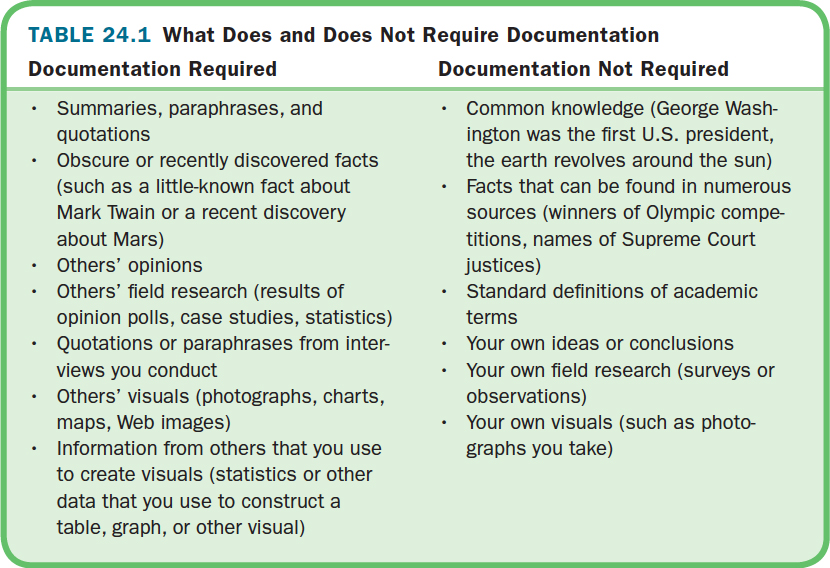AVOIDING PLAGIARISM
After you have decided what source information to use, you will need to build that information into your essay. Three common methods for extracting information — summarizing, paraphrasing, and quoting — are discussed in Chapter 23. In general, it is best to paraphrase or summarize information rather than quote it directly unless the wording is unusual, beautiful, or unique or if you want to provide the exact statement of an expert on the topic. Quotations are also appropriate when discussing works of literature and historical (primary) sources. (More information on integrating quotations into your paper appears below.)
Regardless of how you integrate sources, be sure to acknowledge and document all ideas or information you have borrowed from sources that is not common knowledge. Remember that you must cite your sources regardless of whether you are using direct quotations, paraphrases, or summaries and regardless of whether the information or ideas came to you from a book, an article, a Web site, or even a conversation. Failing to cite a source, even by mistake, may be considered plagiarism.
WHAT IS PLAGIARISM?
Plagiarism is the use of someone else’s ideas, wording, organization, or sentence structure without acknowledging the source. At most schools, both intentional (deliberate) plagiarism and unintentional (done by accident) plagiarism are considered serious forms of cheating and carry the same academic penalties, generally a failing grade or even permanent expulsion.
- Accidental plagiarism: Taking information from a journal article on the uses of eye contact in communication and not indicating where you got the information.
- Deliberate plagiarism: Copying the six-word phrase “Eye contact, particularly essential in negotiations” from a source without enclosing it in quotation marks.
Buying a paper and submitting it as your own work is plagiarism, but so is cutting and pasting text directly from an electronic source into your notes and then into your essay without giving credit.
Instructors may use Internet tracking resources like Turnitin.com, or they may paste a student’s paper into a Google search box to check for plagiarism, so managing the information you have borrowed from sources is crucial. The quick reference guide below can help you determine if you have plagiarized.
QUICK REFERENCE GUIDE TO PLAGIARISM | |
You have plagiarized if you:
|
|
HOW TO AVOID PLAGIARISM
Plagiarism is a serious matter, but it can be avoided if you follow these tips.
- Take careful notes. Place anything you copy directly in quotation marks and record the source. Record the source for any information you quote, paraphrase, summarize, or even comment on.
- Be sure to separate your own ideas from ideas expressed in the sources you are using. Use different colors, different font sizes, different sections of a notebook, or different computer files to distinguish your ideas from those of others. Or take notes in two columns, with ideas and information from sources in one column and your own comments in another.
- Never copy and paste directly from an online source into your paper. Instead, cut and paste information you want to save into a separate file. Enclose the material you pasted in quotation marks to remind yourself that it is someone else’s wording, and record the source information.
- Paraphrase information from sources carefully. Paraphrasing is a great way to test your understanding of sources and to avoid overquoting, but be careful that when you paraphrase, you restate the author’s ideas in your own words and sentences. (For detailed instructions on how to paraphrase without plagiarizing, see Chapter 23. Click here for a bibliographic worksheet.)
- Record all the information you will need to access and cite the source. Include the name of the site, the URL, your date of access, and so on.
DECIDING WHAT TO DOCUMENT
You must document all information and ideas you get from a source unless that information is common knowledge. But what is common knowledge, and how can you tell? Common knowledge is information that is widely available and undisputed. The fact that George Washington was the United States’ first president is common knowledge; so is the fact that the earth revolves around the sun. A good rule of thumb is that if a piece of information is available in a minimum of three reliable sources, then it is considered common knowledge. Of course, you will never be wrong if you cite the source, and you can always ask your instructor or a reference librarian if you are unsure about whether to document something. Table 24.1 also summarizes the types of material that do and do not require documentation.
